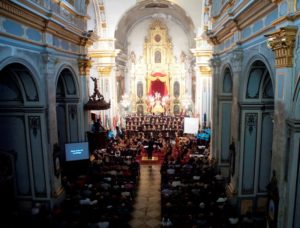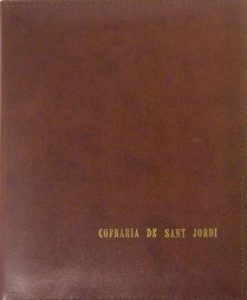During the Festa de Sant Jordi there are many important events that are regulated in the official program, it is a list where the transfer of the pattern cannot be missing, the tumbling of bells, offers it, the Angelus, the entrance, the parade, the targets, etc. But there are acts or things that may never appear
in the program and it is good that it is so. Some of these things could be considered secondary, but they have their essence and are perfectly integrated in the logic of the party.
One is the rain of colored papers that falls at the end of the Mass of Sant Jordi, a moment full of magic and seduction. I don't think it is announced in any program that this type of rain should occur every time
23 d'abril, and it has probably been raining paper for many, many years. It is an act that pleases, of course, to the children, and the same for adults, because when the first flurries of papers appear all the faces of the square light up, it's lightning, and the smile transforms the looks of the attendees. The entire Plaça Major is transformed by the deluge of papers that attracts attention following them in their capricious flight, now grouped together now solitary, oscil•lant, flashing, gently descending like a snow of generous volves, trembling in suspense, vibrating suspended, vacil•lant, until they crash into people, against the ground. Some end up blown by the wind into unexpected corners and holes, and there they can stay as a witness for many days.
In the blink of an eye you can see that the pieces of paper have some verses, What will these verses say?? It's an obvious question, easy to answer: allusive phrases and exaltation of the party, of the pattern, of the population, verses
who have come down from heaven, more or less simple or obvious, with the mission of connecting us collectively in a social and festive imaginary. Along the years, the texts of these papers will have had many variations, outside
curious to look it up sometime, because a written piece of paper always carries a message and has a communication function. These forms of expression have been around for centuries, considered ephemeral literature, they appear in informal or festive contexts as is the case we are dealing with now.
In the present, in Banyeres de Mariola, these slips have a kindly beatific and festive feel to them, maybe it hasn't always been this way, elsewhere they often have a burlesque intent, critical or satirical, socially integrated. I have been told that Mr. Gori Molina Ribera took charge of this pile of paper throughout his life and, after him, The Confraternity of Sant Jordi is diligently taking care of it, and may it continue! Despite the possible coincidences, the aforementioned pieces of paper with verses or jokes,
among other places, they can also be found in Alcoy, where they are thrown in the procession of the Whistles or the Encontre, which takes place at dawn on Glory Sunday; in Ondara, also the same matinee of Gloria, in the procession is
they throw candies and some silk papers with the verses («Al•leluia, al•leluia, Christ is risen"), after the descent of a child characterized by an angel from the Clock Tower. I, in other forms, now on the posters of the Valencian fallas, we find an important presence of this festive and ephemeral literature, but vigorous, and always with varying degrees of satire and criticism.
Like this, returning to the context of the Moors and Christians, we also find a long tradition of verses, which at some point would be transmitted orally, later converted into ephemeral prints they have circulated until now and have not completely disappeared, however little attention is paid to them. These are burlesque compositions, maybe quartets, decimetes, romances or free poems, which usually appear in a flyer talking about the party, of the captain, of the flag, of the captaincy, so and so and so forth. Indeed, the party contains many humorous and critical elements that, for several reasons, civil or religious, in some cases they persist and in others they disappear; the phenomenon, anyway, it has a long tradition and represents a festive compensation law. Remember that in the humor band at the party we can frame, above all, the humorous embassies, Mohammed with his role of interaction in various acts of the party, the parade with lanterns in the form of figures that will burn, the recited
of poems to the captaincy…
This tradition is very old, coming from the medieval centuries, but in the baroque era (between 1600 and the 1750) it is accentuated on the occasion of religious and civil celebrations and commemorations, whether they are occasional or
cyclical, then take flight a large amount of festive manifestations in which, in addition to the papers, a certain scenography takes place, bow dances, parliament, giants and dwarfs, struggles, triumphal arches, floats, occasional sources of wine, rockets, and the most unexpected or improvised elements that will only last for the duration of the celebration.
Now I don't know how to detail all the elements of the party, but let's keep in mind that mainly this is configured with the tension between the dualities: seriousness/humor, religious/secular, regulated/spontaneous, which alternate closely in order for the party to develop as expected; when an aspect is decompensated, new senses will be produced that can be readjusted again, better or worse, until they stop at the structure
ever, in other words that is, traditional, more or less.
Like this, we can already see that the printed word plays a major role in the party, now in flyer form, and so many washers, because in the cases of Banyeres, Alcoi and Ondara must arrive by air and occupy as much space as possible. They are papers, it's not confetti, as is evident, due to their dimensions they look like a cigarette but this still allows them to make the appearance of rain with all its symbolism. The achieved effect of looking like rain is convincing and, like this, without giving up the first objective which is to spread verses exalting the party, it causes an emotion in people, the coming of words, of verses echoing in the air. The confetti also has that well-known hugging effect, of immersion that is contagious
of joy, it is not the case now, but I am referring to an event in which the confetti does create a very special atmosphere, this happens during the Festa d'Elx, in the Mystery. Here the confetti is not paper, It is called oripell (gilded paper, formerly painted copper sheets) and produces effects of divine light that it embodies, especially at the moment of the coronation of the Virgin Mary. It is also launched by the angels in the mangrana (from handkerchiefs tied to their fists), it still appears as an ornament on aerial devices and in the golden palm.
Allow me to point out these comparisons without intending to pass off an ox as a fat beast, and aware of the schematism I try to highlight the breadth of the phenomenon of papers falling from the sky, a carrier air effect
of more or less sublime messages, in relation to a certain celebration that is full of symbols and details that have often lost their original meanings or have been misrepresented. Like this, when we are humble and keep and represent popular traditions faithfully,
we revive certain values and also certain knowledge that make full sense in our days, in which the emotions and experiences caused by the party also have their place.
QUARTET
You can take a good look at it now,
that Saint George, with a lot of trace,
of a deluge of paper
will fill the entire square.
DECIMETA
Do you want to know the race?
what the procession is doing today?
The square and Carrer Majors,
by Felipe Fourth and Laporta,
Ángel Torró will cross,
Laporta will continue right
and will enter by Sant Pere
from the Cross to the Church.
You already have ten stripes
all round explained.











